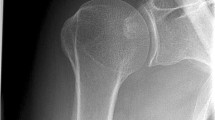Abstract
Objective
Humeral tuberosity cysts are a common finding, with previous reports suggesting they are related to rotator cuff tear or aging. The aim of this study was to investigate the characteristics of cysts in the tuberosities of the humeral head and their relationship with rotator cuff tear and age.
Design and patients
Shoulder MR arthrograms were reviewed in 120 consecutive patients—83 males (mean age 38.0, range 19–59 years) and 37 females (mean age 41.2, range 15–59 years). Patients were referred for investigation of a variety of conditions, and instability was suspected in only a minority of cases. MR was performed before and after direct arthrography with 0.01% solution of gadolinium. Cysts were defined as well-demarcated circular/ovoid foci in two planes that demonstrated high signal on pre-arthrographic T2W sequences. Location, size and numbers of cysts and post-arthrographic enhancement were documented, along with the location of rotator cuff tears, if present.
Results
Cysts in the tuberosities of the humerus were identified in 84 patients (70%), and were seen seven times more frequently in the posterior aspect of the greater tuberosity than anteriorly. Most cysts (94%) demonstrated communication with the joint post-arthrogram. Rotator cuff tears were present in 36 patients, and 79% of all tears occurred in supraspinatus tendon. There was no significant difference in the occurrence of cysts between patients older or younger than age 40 or between genders, but rotator cuff tears were seen significantly more often in the older age group (p<0.01). Tuberosity cysts and rotator cuff tears did not appear to be related (p=0.55). However, whilst this lack of association was quite obvious posteriorly (p=0.84), the trend in the anterior aspect of the greater tuberosity is not as clear (p=0.14).
Conclusions
Humeral cysts are most often located in the posterior aspect of the greater tuberosity, communicate with the joint space and, in this location, are not related to aging or rotator cuff tear.



Similar content being viewed by others
References
Hamada K, Fukuda H, Mikasa M, Kobayashi Y. Roentgenographic findings in massive rotator cuff tears. A long-term observation. Clin Orthop 1990;254:92–96
Neer CS 2nd. Impingement lesions. Clin Orthop 1983;173:70–77
Tuite MJ, Toivonen DA, Orwin JF, Wright DH. Acromial angle on radiographs of the shoulder. correlation with the impingement syndrome and rotator cuff tears. AJR Am J Roentgenol 1995;165:609–613
Norwood LA, Barrack R, Jacobson KE. Clinical presentation of complete tears of the rotator cuff. J Bone Joint Surg Am 1989;71:499–505
Pearsall AW, Bonsell S, Heitman RJ, Helms CA, Osbahr D, Speer KP. Radiographic findings associated with symptomatic rotator cuff tears. J Shoulder Elbow Surg 2003;12:122–127
Sano A, Itoi E, Konno N, Kido T, Urayama M, Sato K. Cystic changes of the humeral head on MR imaging. Relation to age and cuff-tears. Acta Orthop Scand 1998;69:397–400
Cotton RE, Rideout DF. Tears of the humeral rotator cuff; a radiological and pathological necropsy survey. J Bone Joint Surg Br 1964;46:314–328
Wright T, Yoon C, Schmit BP. Shoulder MRI refinements. differentiation of rotator cuff tear from artifacts and tendonosis, and reassessment of normal findings. Semin Ultrasound CT MR 2001;22:383–395
Connor PM, Banks DM, Tyson AB, Coumas JS, D’Alessandro DF. Magnetic resonance imaging of the asymptomatic shoulder of overhead athletes. a 5-year follow-up study. Am J Sports Med 2003;31:724–727
Needell SD, Zlatkin MB, Sher JS, Murphy BJ, Uribe JW. MR imaging of the rotator cuff. peritendinous and bone abnormalities in an asymptomatic population. AJR Am J Roentgenol 1996;166:863–867
Huang LF, Rubin DA, Britton CA. Greater tuberosity changes as revealed by radiography. lack of clinical usefulness in patients with rotator cuff disease. AJR Am J Roentgenol 1999;172:1381–1388
Author information
Authors and Affiliations
Corresponding author
Additional information
An erratum to this article can be found at http://dx.doi.org/10.1007/s00256-006-0207-0
Rights and permissions
About this article
Cite this article
Williams, M., Lambert, R.G.W., Jhangri, G.S. et al. Humeral head cysts and rotator cuff tears: an MR arthrographic study. Skeletal Radiol 35, 909–914 (2006). https://doi.org/10.1007/s00256-006-0157-6
Received:
Revised:
Accepted:
Published:
Issue Date:
DOI: https://doi.org/10.1007/s00256-006-0157-6




